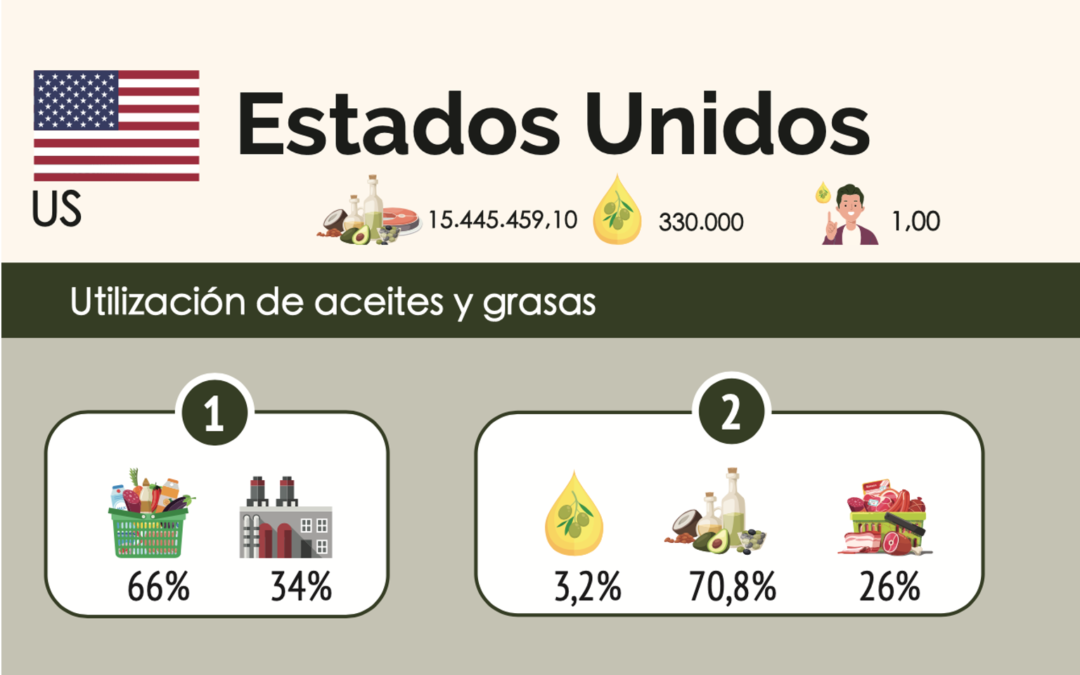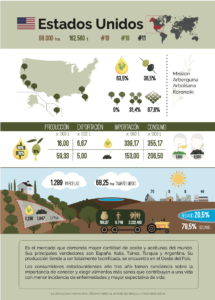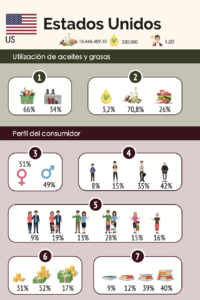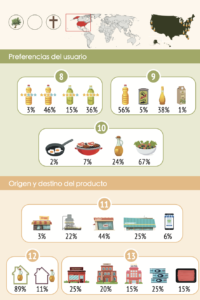There are 198 olive oil consuming countries in the world, of which only 66 are producers.
The consuming countries are classified into three major groups: a. Large producers. B. Small producers; and c. Non-producers.
Within the category of small producer countries, the USA and Brazil stand out. The USA is the largest consumer of olive oil in the world within its category.
The United States ranks 18th in terms of the area of olive groves cultivated in relation to the other producing countries, which currently amount to 66. It is the second largest producer in the Americas, preceded by Argentina. It represents 0.75% of the world olive grove area, with 88,000 hectares occupied by this crop.
The main olive grove plantations are located on the southwest coast of the country, mainly in the valleys of California where a Mediterranean climate is present.
99% of olive oil is produced in the state of California. It is produced in the San Joaquin and Sacramento valleys, which are very dense plantations and the most productive. The remaining 1% is produced in the states of Texas, Georgia, Florida, Arizona and Hawaii.
The American olive grove type is entirely modern, 31.4% are modern high-density olive groves and 67.6% are modern super high-density olive groves. In order to reduce labor costs and speed up harvesting times, production tends to be done totally mechanically, which guarantees excellent harvesting efficiency. 79.5% of the olive grove is cultivated under rainfed irrigation and the remaining 20.5% under irrigated irrigation.
The olive groves are distributed over 1,289 plots, with an average area per plot of 68.25 ha. The main varieties grown are Mission, Arbequina, Arbosana and Koroneiki.
63.5% of the olive grove area is used for oil production, while the remaining 36.5% is used for table olives.
As for the productivity of the plantations, 1.847 tons of table olives are produced per hectare and around 0.286 tons of olive oil are obtained per hectare with an average yield of 16%.
Of the total olive oil produced, 90% is virgin and extra virgin olive oil, and the remaining 10% is lampante virgin olive oil.
The U.S. olive oil industry has 70 olive mills and 44 millers. Of the 70 mills, 45 are located in California.
Currently, the olive sector generates approximately 108 million euros per year and provides more than 2.22 million real working days, which translates into 9.75 thousand permanent jobs.
In terms of consumption, the United States is the market with the highest demand for olive oil and table olives in the world. It is the third largest consumer of olive oils, preceded by Italy and Spain. Its main sellers are Spain, Italy, Tunisia, Turkey and Argentina, from which it imports 340,000 tonnes of olive oil on average.
Two thirds of the olive oil consumed is destined for human consumption and the remaining third for industrial use.
The United States is the main olive oil consumer market outside the European Union, with 330,000 tons of olive oil, which represents 3.2% of the total oils and fats consumed in the country. The per capita consumption of olive oil is one liter per person per year, well above the world average of 0.45 liters per person per year.
However, olive oil consumption is lower than vegetable oil and canola oil consumption. The markets where olive oil consumption is highest are Boston, New York and Miami.
The biggest consumers are people with a secondary or university education (79%), middle income and over 49 years old. The biggest consumers are those over 65 years old, who represent 42% of the total amount of olive oils consumed, followed by the age group between 50 and 65 years old (35%), mostly men (51%). Middle-aged families with children are the ones who consume more olive oil, representing 28% of the total consumption compared to young couples without children who consume 9%.
The type of oil most consumed by Americans is olive oil (46%), followed by extra virgin olive oil (36%). Olive oil for Americans is a gourmet product, which is why 67% of the olive oil consumed is raw and the remaining 33% is used for frying, grilling or cooking.
Finally, and exceeding the world average, most of the olive oil is consumed at home (89%) and only 11% outside the home. Of this 11% of consumption outside the home, 25% is consumed by the canning industry and another 25% in the hotel and catering industry, 20% is consumed in the educational sector and the remaining 30% is consumed in hotels and processing industries.
The places where they buy them are supermarkets and hypermarkets (69%), 22% of the purchases of olive oil are made directly in the oil mill, bottling plants or other points of sale. Internet sales do not represent a high percentage, only 6% of olive oil purchases are made by this means.
Year after year, American consumers are becoming more aware of the importance of knowing and choosing healthier foods that contribute to a life with a lower in




